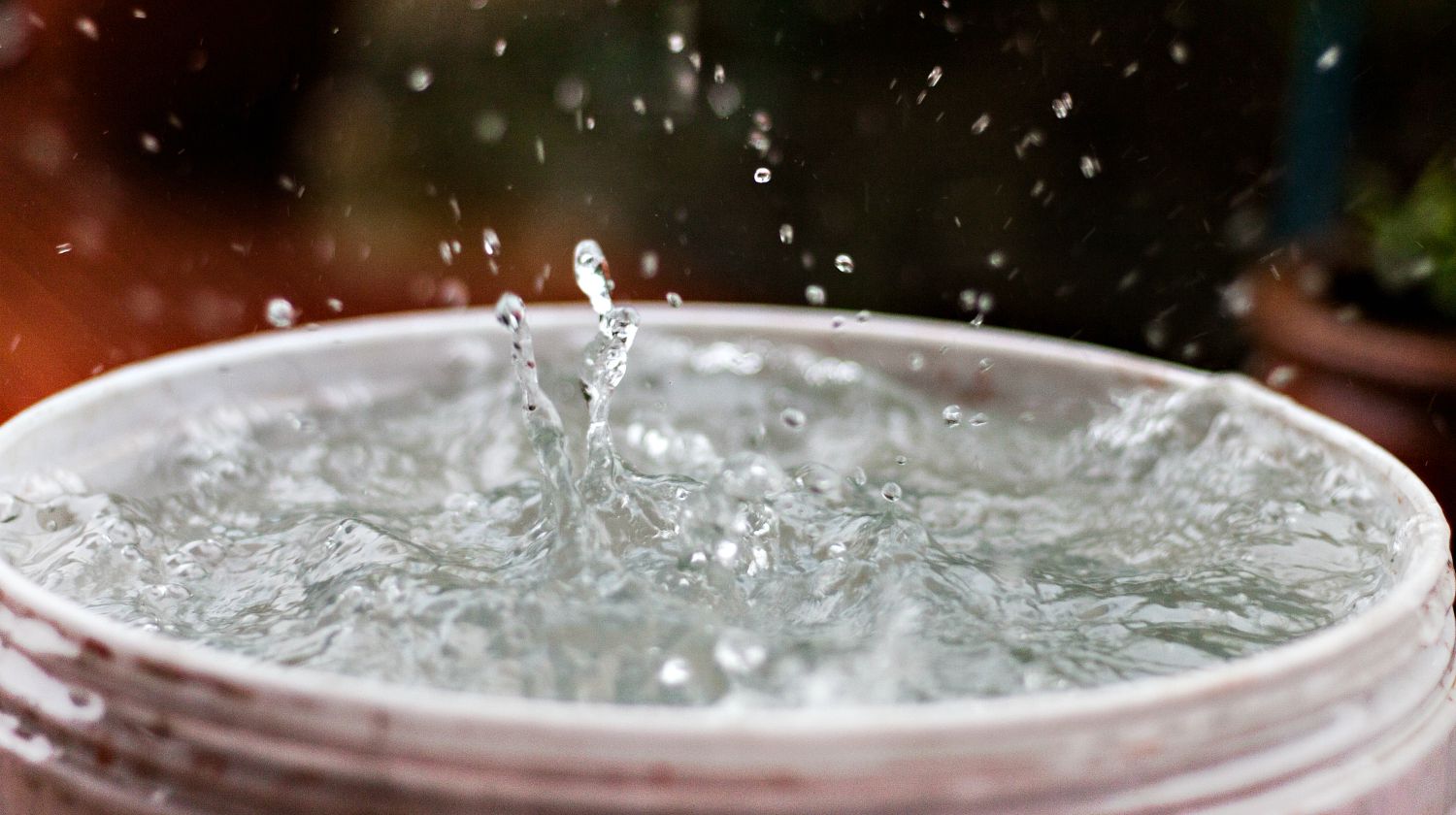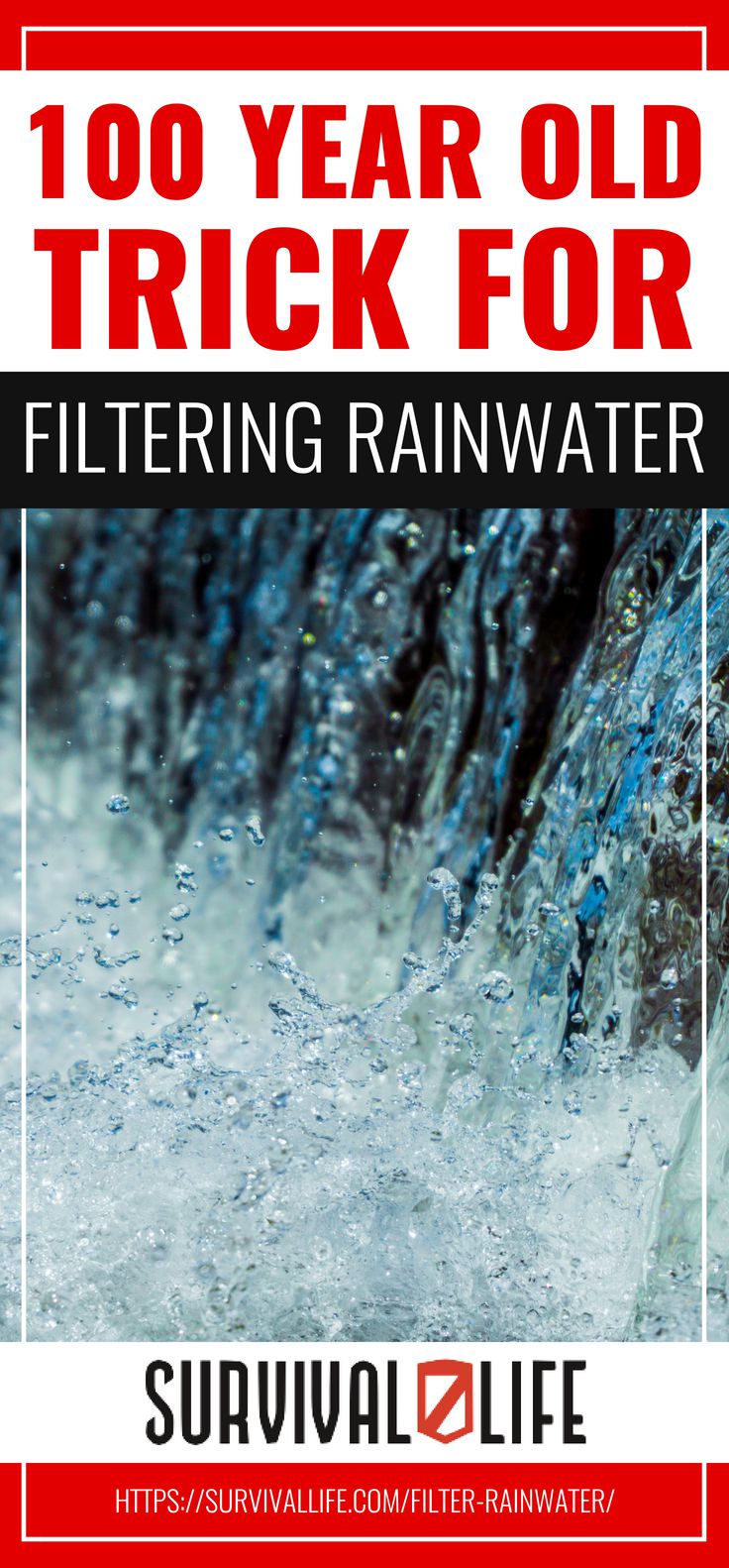Self Sufficiency
100-Year-Old Trick For Filtering Rainwater

Today we all rely on bottled water and tap water that only a few of us know how to filter rainwater. Learn this survival skill as an essential method for collecting clean water.
RELATED: DIY Rainwater Collection System
In this article:
- Importance of Rainwater as a Clean Water Source
- Water Shortage in Summer
- Traditional Water Supply
- Old Homemade Water Filtration System
- Rainwater Filter Instructions
- Other Uses of Trickle Filters
- Online Reading
Filtering Rainwater Collection Using the Old Method
Importance of Rainwater as a Clean Water Source
Rainwater is an abundant source of water for any domestic and agricultural need and can be harvested easily. But filtering rainwater can be difficult and costly in modern times.
Instead, find out how they filtered rainwater 100 years ago and make your own!
Water Shortage in Summer
During our boiling, broiling, blistering summer of 2012 here in the Missouri Ozarks, water was a topic of conversation wherever we go. Creeks and ponds dried up (some never recovered) and the water table dropped, forcing a few neighbors to have their well pumps lowered or to even have deeper wells drilled.
Traditional Water Supply
Many folks shared memories of rainwater collection system, rain barrels, cisterns, hand pumps, and drawing water with a well-bucket as a child usually on grandpa and grandma’s farm.
Some said they’d never want to rely again on those old-time methods of getting water. But, at least they knew how it was done.
Old Homemade Water Filtration System
A tattered, 4-inch thick, 1909 book I happily secured for $8 in a thrift store reveals, among umpteen-thousand other everyday skills, how to make homemade water filters. The instructions in “Household Discoveries and Mrs. Curtis’s Cookbook” are quite basic as everyone had a rain barrel back or rainwater collection tanks then and presumably knew how to clean the water.
Now, 104 years later, I am thankful the authors had the foresight to preserve their knowledge for us and pointed out that rainwater collected in barrels from a roof is a necessity in some locations but also is best for laundry and “often more wholesome for drinking purposes than hard water.”
Rainwater Filter Instructions
Step 1: Prepare the Container
|
Take a new vinegar barrel or an oak tub that has never been used, either a full cask or half size. Stand it on end raised on brick or stone from the ground.
Insert a faucet near the bottom. Make a tight false bottom 3 or 4 inches from the bottom of the cask.
Perforate this with small gimlet holes and cover it with a piece of clean white canvas.
RELATED: The Do’s And Don’ts Of Building Your First Rain Barrel
Step 2: Cover the False Bottom
|
Place on this false bottom a layer of clean pebbles 3 or 4 inches in thickness. Next, place a layer of clean washed sand and gravel and then coarsely granulated charcoal about the size of small peas.
Charcoal made from hard maple is the best.
Step 3: Add the Final Layer of the Strainer
After putting in a half bushel or so, pound it down firmly. Then put in more until the tub is filled within 1 foot of the top.
Add a 3-inch layer of pebbles and throw a piece of canvas over the top to act as a strainer.
Tip: Later, you can remove this canvas strainer and wash it occasionally. When you dump the contents of the cask, you can also clean the pebbles.
Then renew the charcoal every spring and fall or once a year.
Other Uses of Trickle Filters
|
This also makes a good cider filter for the purpose of making homemade vinegar. The cider should first be passed through cheesecloth to remove all coarser particles.
You can also make a small cheap filter from a flower pot. A fine sponge may be inserted in the hole and the pot filled about as directed for the above filter.
It may be placed in the top of a jar which will receive the filtered water.
Online Reading
My copy of the 1,000-page book is stained and worn, I assume from many years of use in the house, barn, and garden.
Even though I could read the bright, white online version, I treasure my rag-tag book and am hanging onto it. I still have much to learn.
Linda Holliday lives in the Missouri Ozarks where she and her husband formed Well WaterBoy Products, a company devoted to helping people live more self-sufficiently off the grid and invented the WaterBuck Pump. A former newspaper editor and reporter, Holliday blogs for Mother Earth News, sharing her skills in modern homesteading, organic gardening, and human-powered devices.
Find out what mistakes to avoid during rainwater harvesting in this short video by David The Good:
This vintage book offers a cheap and easy way to make a rainwater filter just as good as a patent filter which costs 10 times as much. This 100-year-old filter may be set in the cellar and used only for drinking water.
It may also be used in a time of drought for filtering stagnant water which would otherwise be unpalatable for the use of stock.
What do you think of this 100-year-old rainwater filtration technique? Share your thoughts in the comments section below!
UP NEXT:
- 8 Emergency Water Storage Tips For Preppers Like You
- How Camping In The Rain Can Prepare You For A Disaster
- Amazing! Stay Cool With This Solar Powered Air Cooler! [DIY]
For awesome gear that can also help you in a survival situation, visit the Survival Life Store!
Subscribe to our Newsletter by clicking here.
Follow us on Facebook, Instagram, Twitter, Pinterest, and Tumblr!

Editor’s Note: This post was originally published on December 15, 2015, and has been updated for quality and relevancy.
-

 Do It Yourself7 months ago
Do It Yourself7 months agoParacord Projects | 36 Cool Paracord Ideas For Your Paracord Survival Projects
-

 Do It Yourself9 months ago
Do It Yourself9 months agoHow To Make Paracord Survival Bracelets | DIY Survival Prepping
-

 Do It Yourself9 months ago
Do It Yourself9 months ago21 Home Remedies For Toothache Pain Relief
-

 Do It Yourself10 months ago
Do It Yourself10 months agoSurvival DIY: How To Melt Aluminum Cans For Casting
-

 Exports8 months ago
Exports8 months agoAre Switchblades Legal? Knife Laws By State


JJM
January 21, 2016 at 12:32 AM
Container, sand, gravel and cloth filters are readily available. Would like to see more of these instructions to include how to make charcoal. Not too difficult but there are recommended methods.
Pingback: How To Purify Water - Survival Water Purification | Survival Life
Pingback: How To Purify Water | 5 Water Decontamination Techniques
Former Visitor
April 28, 2017 at 10:40 AM
Your site is almost impossible to read anymore with the black menu header covering a third of the top, the red band across the bottom, and your social icon images covering the first word or 2 down the left side. I don’t stay on or visit a site where I have to struggle to read.
PaulfromTexas
April 28, 2017 at 11:18 AM
you saved me typing all that……
Anonymous
July 12, 2018 at 1:18 PM
Same here !
Anonymous
February 25, 2019 at 7:44 AM
Same.
Anonymous
April 18, 2019 at 4:22 PM
same too
gtonanna
April 28, 2017 at 5:57 PM
I have a rain catchment system with first flush, but with asphalt shingles on the roof ,we do not drink this water but use it for flushing toilets and in the garden.I would love to have a tin roof but can’t afford one.
Anonymous
March 11, 2019 at 11:13 PM
My paternal grandparents had a cistern in the basement of their brick farmhouse near Peterborough, Ontario, Canada. Their enameled farm kitchen sink had an integral dish drainer and 2 spouts, one was mixed hot & cold and the other was well water from a dug well for drinking. The cistern almost reached the rafters and we could hear frogs croaking in it. It was filled from the rain water downspouts which were galvanized steel. At their cottage they had a dug well which was large enuff diameter that the concrete casing was placed on the ground and we each took turns digging out dirt within the casing so that it slowly lowered into the ground. Then another section of casing was placed on top of the first one and we would continue digging. I think we hit water about 15 feet down & the diggjng was easy as it was sandy soil being within a hundred fet of the lake. Grandpa took water samples into the lab in peterborough each spring for testing. This is all in the early 1950s
Pingback: 100-Year-Old Trick For Filtering Rainwater - Survive!
Pingback: 100-Year-Old Trick For Filtering Rainwater
Fortunate1
July 12, 2018 at 10:39 AM
I may have missed it reading this on my phone. What is the name of the 1000 page book?
Lane
July 13, 2018 at 7:25 PM
Hey, what is the name of the book? Maybe, I can find it at second hand book store too.
Anonymous
March 11, 2019 at 10:54 PM
Read the article & the comments & you will see all the details at least 3 places
Kevin
July 14, 2018 at 7:38 AM
I liked the comments Stephen and Ken contributed but the others not so much. If you don’t like all the pop ups, commercials, etc. why read the story? Your free to leave and go somewhere else. After all its free info to use at will. I am grateful a site like this exists. Too many whiners. Who cares if the site is trying to make money, no profit no info.
Anonymous
March 11, 2019 at 10:51 PM
Works fine on my Samsung tablet
Coleman
February 27, 2019 at 7:53 AM
Good, U can filter rain water… HOW do U filter out the Crap from the Chem Trails???
Mike
March 5, 2019 at 9:04 AM
Can you use a plastic barrel?
Rod
March 11, 2019 at 10:23 PM
I wud use the blue plastic olive barrels that come from Spain or Greece and held olives for repackaging in canada
James R
September 12, 2019 at 7:09 AM
Thank you ! Great articles for a more independent life.